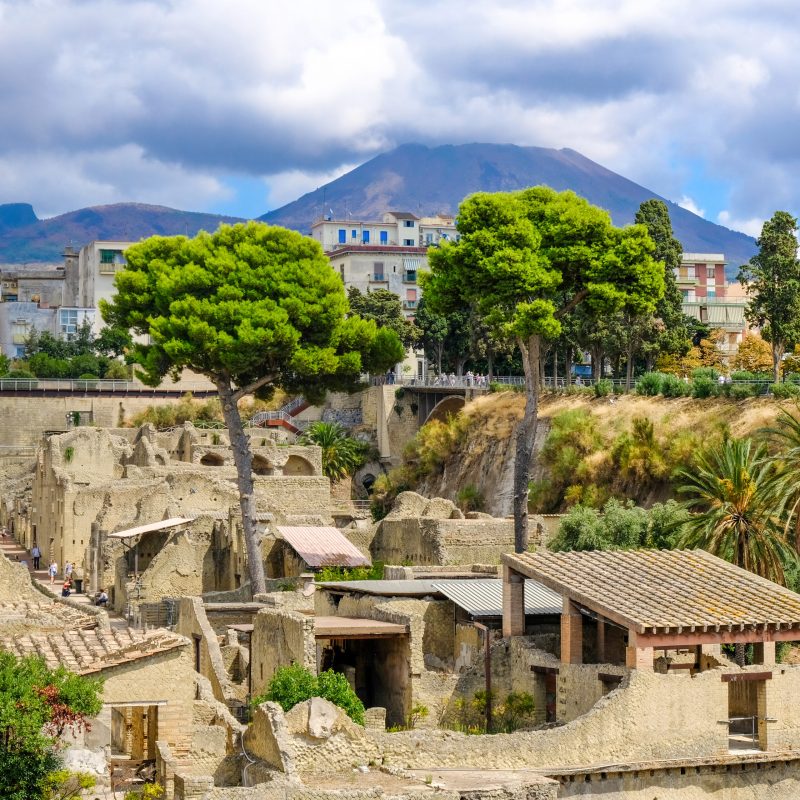
By now, the story is familiar: In the fall of 79 A.D., Mount Vesuvius, located in present-day Campania, erupted in a fiery storm that blanketed a wide band of Italy’s western coast in ash, pumice, and rock fragments.
Videos by TravelAwaits
The next day, repeated surges of pyroclastic flow — a fast-moving mixture of molten lava, ash, and gases that generated 100,000 times the thermal energy of the Hiroshima bombing — blasted into the Roman cities of Pompeii and Herculaneum, collapsing roofs and support structures. Those who had not already perished from thermal shock died of suffocation.
Pompeii and Herculaneum lay forgotten — under more than 20 feet and 70-plus feet of ash, respectively — for centuries. Then they were discovered in the 1700s, and have been a point of fascination for travelers ever since. Conventional wisdom says you should visit one site per day. But what if your packed Italian itinerary includes only a single day for touring the ruins?
It is possible to see Herculaneum and Pompeii in a day, and get an invaluable glimpse into life in antiquity. Beyond the numerous facts you’ll discover from their official tour booklets — some of which are included here — Pompeii is an extraordinary showcase of the everyday, from residential living to commerce, spirituality, and government. But because so much of the excavation (and subsequent plundering and vandalism) over the centuries has taken place here, its condition has deteriorated drastically. Still, Pompeii gives an unmatched perspective on the scale of the disaster.
Herculaneum is smaller but far less crowded, and in a much better state of preservation. A wealthy city, its structures are often more beautiful and include many intact frescoes and mosaics. You can also witness the work of restoration specialists in real time.

Start With Pompeii
Pompeii draws massive crowds. Get there 10 minutes before opening (9 a.m. on weekdays; 8:30 a.m. on weekends), and you’ll be assured of a short ticket line and about 90 minutes of quiet touring before the tour buses arrive. You’ll also have a couple hours before the sun is at its highest and the heat of the day kicks in, which is important at this almost entirely open-air site.
Taxi and rental cars to Pompeii cost between 30 and 100 euros, depending on whether you’re coming from a closer location like Naples or somewhere farther away, such as Sorrento, plus parking fees if you opt for a rental. The bus is cheap at 3 euros or less from nearly all locations along the coast of Campania, but delays are common. For about the same price, the Circumvesuviana train bypasses the highway and deposits you at Pompeii Scavi station, less than a 5-minute walk from the site’s Porta Marina entrance.

What To See in Pompeii
Pompeii is sprawling, with 163 acres divided into 9 regions (about 30 percent remains unexcavated). Plan to spend 3 to 4 hours, progressing through the must-see highlights in this order: Region 6, 7, 8, 1, and 2.
House of the Tragic Poet (Region 6): An atrium house, this dwelling is famous for its Cave Canem mosaic at the entrance — the world’s first “Beware of Dog” sign.
Villa of the Mysteries (Region 6): This mostly intact structure contains some of the finest frescoes in the city.
Forum (Region 7): The heart of daily civil life in Pompeii, this public space is surrounded by administrative and public buildings.
Forum Granary (Region 7): Pompeii’s vegetable market, the Granary houses 9,000 of the site’s artifacts, including terracotta crockery and amphorae, marble fountains, and copies of plaster casts of some of the victims.
Lupanar (Region 7): This is one of the most-visited sites at Pompeii, thanks to its provocative carved phalluses and erotic frescoes. But these images are idealized. Pompeii’s sex workers (according to the Pompeii tour book) were mostly women, and slaves of Greek and Asian origin, who worked in spaces no larger than prison cells.
Basilica (Region 8): Adjacent to the Forum, the opulently designed Basilica was an administrative and business space. The raised loggia was used for tribunals.
Amphitheater (Region 2): Among the oldest outdoor theaters of the Roman world, the amphitheater held 20,000 spectators.
Also See:
- Region 1: House of Paquius Proculus, House of the Citharist
- Region 2: House of Julia Felix, House of the Triclinium
- Region 6: House of the Oven, House of Sallust, House of the Faun, Necropolis of the Herculaneum Gate
- Region 8: Temple of Isis, Gladiators’ Barracks

Getting From Pompeii To Herculaneum
Herculaneum is just under 11 miles from Pompeii. Car and taxi rides take 20 to 40 minutes, depending on traffic; for parking, follow the parcheggio signs to the on-site underground lot.
Alternatively, in about 30 minutes, and for less than 2 euros, the Circumvesuviana train will take you from Pompeii Scavi station to Ercolano Station. Walk out the exit and down the hill for about four blocks to Herculaneum’s main entrance.

What To See In Herculaneum
Because Herculaneum is more contained, you’ll need only two to three hours to see it. Start at the main gate, following a sort of reverse-numerical order.
Hall of the Augustals: A gathering place for freed slaves, this space has arched walls, four central columns, and multiple frescoes.
Cucumus Shop: This store retains its painted sign with four colored pitchers, wine prices, and an ad for a show.
House of Neptune and Amphitrite: This home has several mosaics, including a shrine to nymphs rendered in tile, seashells, and lava foam, and topped with marble theatrical masks.
Shop: Get a glimpse of the kitchen and rooms on the upper floor of this well-preserved shop through a partially collapsed portion of ceiling. The shelving is original; the wood was carbonized in the blast.
House of the Wooden Partition: It doesn’t look like much from the outside, but step through the narrow, painted corridor and you’ll find an incredible folding gate made of raised wood panels.
House of the Telephus Relief: The second-largest complex in Herculaneum, this was a three-level structure overlooking the marina. The discs between the columns warded off evil.
Barrel Arches: These vaulted rooms opened onto the beach and were used for the storage of port wine and boats. In the 1980s, 300 human skeletons were found inside — residents who fled to the shore, waiting for rescue that would never come. Ending your trip here is a poignant way to reflect on the tragedy that consumed multiple cities and killed an estimated 16,000 people.
Also See:
- Villa of the Papyri
- House of Argus
- Inn House
- Terrace of M. Nonius Balbus
- Women’s Baths
- Lanarius Shop
- Trellis House
- Large Tavern
- House of the Deer

Tips For Visiting Pompeii And Herculaneum
Here are some tips to help you visit Pompeii and Herculaneum in a single day — without driving yourself batty.
- Entry to Pompeii costs 15 euros and Herculaneum is 13 euros. Save your cash on guidebooks by downloading this one for Pompeii free to your phone or tablet. You’ll get a free mini guidebook with admission at Herculaneum.
- For the best photos, take a camera that has a low-light setting.
- Bags larger than 12” x 12” x 5” are prohibited. Luggage can be stored on-site at Herculaneum or at the Pompeii Scavi train station for about 8 euros per bag. Carry bags in front to avoid inadvertently brushing against a centuries-old fresco.
- Take sunblock and a hat; once the Mediterranean sun starts beating down, you’ll be grateful for the protection. Pack a compact umbrella or poncho in case of rain.
- Wear comfortable sneakers or closed-toe walking shoes. The ground at both sites, particularly Pompeii, is uneven and tricky in spots.
- Although both parks are wheelchair and stroller accessible (generally, Herculaneum is better), some buildings don’t have access ramps.
- Take a bottle of water and a light snack to prevent dehydration and keep you fueled till lunch without needing to visit the on-site cafe at Pompeii.
- Speaking of the cafe … just don’t. Not only is the food reminiscent of a high school cafeteria, it’s also overpriced. There are several affordable cafes right outside Pompeii’s walls. Venture a little farther for even better quality.
- Tours, while often led by knowledgeable guides, typically aren’t worth it. They concentrate on a few small areas, and you’ll be forced to move at the group’s pace.
- The sites are fragile, having been eroded by hundreds of years of exposure to shoes, fingers, and backpacks. While it’s safe to snap a selfie in front of columns and steps, climbing on them (or over locked fences, as some bloggers have documented themselves doing) is actually illegal.
- Certain buildings are open during limited hours. If you have your heart set on seeing one, go there first and check the times. Then line up early, especially at Pompeii’s Lupanar.
- Know that you’re in for a long day. Plan to take a couple of breaks at each site, and a longer break between them for a meal.
- Accept that you could spend weeks at each site and never see everything. Instead, linger in a handful of chosen spots for a more memorable experience.
- Rush hour will be underway when you’re ready to head back to your hotel. Instead of fighting traffic, stop in one of the bars between Herculaneum and the train station, take a load off, and sip some limoncello as the sun sets.
Planning a Mediterranean vacation? Don’t miss these seven off-the-beaten-path towns in Italy.
